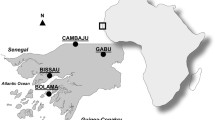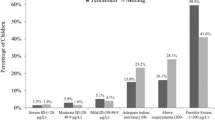Abstract
This study was planned to investigate goiter prevalence and serum selenium and urine iodine status among school-age children in the Ankara region of Turkey. Nine hundred five (905) children were investigated; 847 of them were included in the study. Thyroid ultrasound was performed on children who were suspected of being goitrous at physical examination. Serum TSH, thyroxine, triiodotyronine, thyroid antibody, and urine iodine concentrations (UIC) are also measured. Ultrasound measurements revealed a goiter in 107 (12.6%) of the 847 children. Goiter prevalence was significantly lower among iodized-salt users compared to the noniodized salt using group. UIC and serum selenium levels in the goitrous group were significantly lower compared to the nongoitrous group. Despite legally enforced table salt iodization, the region shows the characteristics of mild iodine deficiency. In addition to lower UIC, goitrous children have lower serum selenium levels compared to the nongoitrous ones. Thus, selenium deficiency plays an important role in goiter endemics in Turkey. It can be postulated that table salt iodization might not be enough for the preventive measures of goiter, but informing people about the correct ways of iodized salt consumption, enforcing the iodization of industrial salts, and, as important as these measures, taking selenium deficiency into consideration are essential for preventing goiters in endemic areas.
Similar content being viewed by others
References
S. C. Boyages, Iodine deficiency disorders, J. Clin. Endocrinol. Metab. 77, 587–591 (1993).
P. A. Lamberg, Iodine deficiency disorders and endemic goitre. Eur. J. Clin. Nutr. 47, 1–8 (1993).
F. Delange, The disorders induced by iodine deficiency, Thyroid 4, 107–128 (1994).
European Thyroid Association, Goitre and iodine deficiency in Europe, Lancet 8441, 1289–1292 (1985).
S. Kurtoglu, E. Olgun, N. Ceviz, et al., Iodine deficiency in pregnant women and their neonates in the central Anatolian region (Kayseri) of Turkey, Turk. J. Pediatr. 46, 11–15 (2004).
R. Gutekunst and P. C. Scriba, Goiter and iodine deficiency in Europe. The European Thyroid Association report as updated in 1988, J. Endocrinol. Invest. 12, 209–220 (1989).
G. Erdogan, M. F. Erdogan, R. Emral, et al., Iodine status and goiter prevalance in Turkey before mandatory iodization. J. Endocrinol. Invest. 25, 224–228 (2002).
I. Urgancioglu and H. Hatemi, Endemic Goitre in Turkey, Cerrahpasa Tip Fak Yay. Emek Matb. Istanbul (1998) (in Turkish).
A. Baki, T. Tezic, and Y. Gedik, Dogu Karadeniz Bolgesi Trabzon il merkezi okul cagi cocuklarinda guvatr prevalansi. Karadeniz Tip Fakultesi Dergisi 1, 24–37 (1986).
E. M. Fordyce, C. C. Johnson, U. R. Navaratna, et al., Selenium and iodine in soil, rice and drinking water in relation to endemic goitre in Sri Lanka, Sci. Total Environ. 263, 127–141 (2000).
G. J. Beckett, F. E. Peterson, K. Choudhury, et al., Interrelationships between selenium and thyroid hormone metabolism in the rat and man. J. Trace Elements Electrolytes Health Dis. 5, 265–267 (1991).
G. W. Geelhoed, Metabolic maladaptation individual and social consequences of medical intervention in correcting endemic hypothyroidism, Nutrition 15, 908–932 (1999).
M. Samir and M. Y. el-Awady, Serum selenium levels in multinodular goitre, Clin. Otolaryngol. Allied Sci. 23, 512–514 (1998).
K. Aydin, M. Kendirci, S. Kurtoglu, et al. Iodine and selenium deficiency in school-children in an endemic goiter area in Turkey, J. Pediatr. Endocrinol. Metab. 7, 1027–1031 (2002).
D. L. Germain and A. V. Galton, The deiodinase family of selenoproteins, Thyroid 7, 655–668 (1997).
M. F. Erdogan, G. Erdogan, M. Sav, et al., Endemic goiter, thiocyanate overload, and selenium status in school-age children, Biol. Trace Element Res. 79, 121–130 (2001).
N. Yordam, A. Ozon, A. Alikasifoglu, et al., Iodine deficiency in Turkey, Eur. J. Pediatr. 158, 501–505 (1999).
WHO, UNICEF, and ICCIDD, Indicators for Assessing Iodine Deficiency Disorders and Their Control Through Salt Iodization, WHO, Geneva (1994).
J. Brunn, U. Blocjk, J. Ruf, et al., Volumetrie der schildrusenlappen mittels real-time-sonografie, Deutsch. Med. Wochenschr. 106, 1338–1341 (1981).
WHO and ICCIDD, Recommended normative values for thyroid volume in children aged 6–15 years, Bull. WHO 75, 95–97 (1997)
K. Megubas, N. A. Diab, and I. G. Gokmen, Selenium status of healthy Turkish children. Biol. Trace Element Res. 54, 163–172 (1996).
F. Delange, Iodine, Ann. Nestle 52, 81–93 (1994).
J. Dunn, H. Crutchfield, R. Gutekunst, et al., Two simple methods for measuring iodine in urine. Thyroid 3, 119–123 (1993).
F. Aghini-Lombardi, L. Antonangeli, A. Pinchera, et al., Effect of iodized salt on thyroid volume of children living in an area previously characterised by moderate iodine deficiency. J. Clin. Endocrinol. Metab. 4, 1136–1139 (1997).
F. Delange, B. Benoist, E. Pretell, et al., Iodine deficiency in the world: where do we stand at the turn of the century? Thyroid 5, 437–447 (2001).
S. Semiz, U. Senol, O. Bircan, et al., Thyroid gland volume and urinary iodine excretion in children 6–11 years old in endemic area, J. Pediatr. Endocrinol. Metab. 13, 245–251 (2000).
G. F. Fenzi, C. Ceccarelli, E. Macchia, et al., Reciprocal changes of serum thyroglobulin and TSH in residents of a moderate endemic goitre area, Clin. Endocrinol. 23, 115–122 (1985).
J. P. Chanoine, V. Toppet, R. Lagasse, et al., Determination of thyroid volume by ultrasound from the neonatal period to late adolescence, Eur. J. Pediatr. 150, 395–399 (1991).
G. J. Beckett, S. E. Beddows, P. C. Morrice, et al., Inhibition of hepatic deiodination of thyroxine is caused by selenium deficiency in rats, Biochem. J. 248, 443–447 (1987).
F. Delange, Adaptation to iodine deficiency during growth (etiopathogenesis of endemic goiter and cretenism), in Pediatric and Adolescent Endocrinology, Karger, Basel, Vol. 14, pp. 295–326 (1985).
B. Giray and F. Hincal, Oxidative DNA base damage, antioxidant enzyme activities and selenium status in highly iodine deficient goitreous children, Free Radical Res. 36, 55–62 (2002).
J. R. Arthur, F. Nicol, and G. J. Beckett, Selenium deficiency, thyroid hormone metabolism and thyroid hormone deiodinases, Am. J. Clin. Nutr. 57(Suppl.), 236–239 (1993).
B. Contempre, N. L. Duale, J. E. Dumont, et al., Effect of selenium supplementation on thyroid hormone metabolism in an iodine and selenium deficient population, Clin Endocrinol (Oxf) 36, 579–583 (1992).
G. F. Fenzi, L. F. Guisti, F. A. Lombardi, et al., Neuropsychological assessment in school-children from an area of moderate iodine deficiency, J. Endocrinol. Invest. 13, 427–431 (1990).
P. Zagrodzki, H. Szmigiel, R. Ratajczak, et al., The role of selenium in iodine metabolism in children with goiter, Environ. Health Perspect. 108, 67–71 (2000).
M. Ozata, M. Salk, A. Aydin, et al., Iodine and zinc, but not selenium and copper, deficiency exists in a male Turkish population with endemic goiter, Biol. Trace Element Res. 69, 211–216 (1999).
B. Giray, F. Hincal, T. Tezic, et al., Status of selenium and antioxydant enzymes of goitreous children is lower than healthy controls and nongoitreous children with high iodine deficiency, Biol. Trace Element Res. 82, 35–52 (2001).
Author information
Authors and Affiliations
Rights and permissions
About this article
Cite this article
Cinaz, P., Karakas, D.S., Çamurdan, M.O. et al. Goiter prevalence, serum selenium, and urine iodine status in a previously iodine-deficient area in Turkey. Biol Trace Elem Res 100, 185–193 (2004). https://doi.org/10.1385/BTER:100:3:185
Received:
Accepted:
Issue Date:
DOI: https://doi.org/10.1385/BTER:100:3:185




